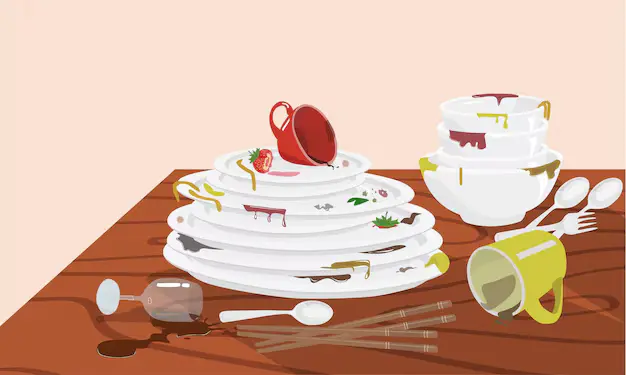Introduction
Kitchens are the heart of every home and a clean kitchen is all about health, hygiene, and creating a space where cooking feels joyful and stress-free. But sometimes it is overshadowed by grease and bad odors. From cooking spills on the stove to overflowing items, it is hard to keep the kitchen spotless . That’s where a smart cleaning comes in. With the right checklist and a few genius hacks, kitchen cleaning doesn’t have to eat up your time or energy.
For families in Surrey, those who are looking for professional help for kitchen cleaning, opting for professional maid service in Surrey is the best option. By combining these kitchen cleaning hacks with a professional house cleaning service, you can ensure your kitchen stays sparkling clean, and hygienic.
As working in the cleaning industry since years, we believe every home deserves a kitchen that shines, without hours of scrubbing. That’s why we’ve created this fast and easy kitchen cleaning guide, so that kitchen cleaning is no more a burden to you. Here, you’ll discover:
- A step-by-step cleaning checklist that covers everything from countertops to cabinets.
- Time-saving hacks that cut through grease and clutter effortlessly.
- Pro tips from Mesh Maids experts that make your kitchen sparkle like new.
With these strategies, you’ll not only enjoy a spotless kitchen but also create a healthier, happier environment for cooking, dining, and making memories with loved ones.
Why Kitchen should be at the Top of the Cleaning Priority List

The kitchen isn’t just where meals are made, it’s also one of the messiest areas of the home. With constant cooking, snacking, and family activity, kitchen naturally collects more dirt, grease, and germs than most rooms.
Here’s why the kitchen demands extra attention:
- Grease & Food Residue – Cooking often leaves behind oil splatters, sticky sauces, and crumbs in corners. If not cleaned at the right time, they can attract pests and bacteria.
- Frequently Touched Surfaces – Quartzite countertops, cabinet handles, faucets, and switches are touched many times a day, making them prime spots for germs to spread.
- Appliance Messes: From the stove (including drip pans) to the fridge and microwave, kitchen appliances collect grime quickly. Without regular cleaning, they can even impact food safety and efficiency.
- Moisture Issues: With sinks, dishwashers, and cooking steam, kitchens are naturally humid. This makes them a hotspot for mold and mildew if not kept dry and clean. Ans always keep in mind that cleaning kitchen sink drain is a must when you are going for kitchen cleaning.
Bonus Tip: Not sure how to clean your dishwasher? Run a hot cycle with white vinegar, then sprinkle baking soda on the bottom and run another short cycle. It helps eliminate odors, grease, and hidden grime!
Whether you’re maintaining a spotless look or protecting your family’s health, we believe your kitchen deserves consistent and thorough attention.
Kitchen Cleaning Checklist: Easy Daily and Weekly Tasks
A structured checklist makes kitchen cleaning less overwhelming and far more efficient. By breaking it down into simple daily and weekly habits, you can keep your kitchen sparkling, hygienic, and clutter-free without spending hours on deep cleaning.
Daily Kitchen Cleaning Tasks
Daily maintenance is the secret to preventing buildup. These small but consistent steps will save you time and effort in the long run while keeping your kitchen guest-ready every day.
1. Wipe Countertops and High-Touch Surfaces
Why it’s important:
It is important specially when you have white kitchen cabinets with black countertops. Countertops, handles, knobs, and other high-touch surfaces in the kitchen are breeding grounds for bacteria, grease, and food particles. Regular cleaning maintains hygiene and gives your kitchen an instant polished look.
What to do:
- Use an all-purpose cleaner or a mixture of warm water and mild soap.
- For more stubborn grime, opt for a non-toxic, kitchen-friendly cleaner.
- Wipe down surfaces with a clean microfiber cloth to avoid leaving streaks.
- Don’t forget the backsplash, especially behind the stove, where grease tends to accumulate.
Benefit:
Regular wiping not only keeps your kitchen sanitated but also gives it an instant polished look. Cleaning as you cook ensures that these don’t turn into big ones.
2. Load and Run the Dishwasher
Why it’s important:
The sooner you clean dishes, the less likely they are to pile up and create a cluttered, dirty environment. Leaving dirty dishes around can attract pests and create unpleasant odors.
What to do:
- Load dirty dishes into the dishwasher immediately after hosting parties like Halloween.
- Rinse off large food scraps before loading to avoid blockages or odor buildup in the machine.
- To keep up with the dishwashing task, run the dishwasher at the end of the day.
Benefit:
This helps you clean as you go, reducing mess and making meal times more manageable. It’s a crucial habit for maintaining an organized and hygienic kitchen.
3. Sweep the Floor
Why it’s important:
Crumbs, spills, and debris on your kitchen floor are magnets for pests and dirt. Regular sweeping helps maintain a clean and safe environment, reducing the likelihood of pests like ants or mice.
What to do:
- Sweep the floor after each meal, especially around food prep areas, dining spots, and the trash can.
- Make sure to clear the floor of large debris first, and then focus on the smaller crumbs and dust.
- For sticky spots, spot-clean using a damp cloth or mop.
Benefit:
Sweeping helps you avoid the accumulation of dirt and food that could otherwise lead to a sticky, unhygienic floor. This quick daily step prevents grime from becoming a bigger problem.
4. Empty the Trash
Why it’s important:
The trash is one of the most unpleasant parts of kitchen maintenance. Overflowing trash can lead to bad odors and make your kitchen look disorganized. Taking out the garbage promptly helps maintain freshness and cleanliness.
What to do:
- Take out the garbage daily, especially if food scraps or organic waste are involved.
- Add a fresh trash liner, and sprinkle a small amount of baking soda at the bottom of the bin to neutralize odors and prevent bacterial growth.
Benefit:
This simple task ensures your kitchen remains free from lingering smells and looks tidy. Keeping the trash empty minimizes the chances of pests being attracted to the area.
Weekly Kitchen Cleaning Tasks
In addition to the daily cleaning tasks, performing these weekly cleaning routines ensures that no part of your kitchen is neglected. Weekly tasks focus on deeper cleaning to keep the kitchen in top condition.
5. Deep Clean the Fridge
Why it’s important:
Fridges can quickly become cluttered with expired food, spilled liquids, and crumbs. Keeping your fridge clean improves food safety and helps reduce food waste. And if you see, mold in your fridge, you should definitely go for fridge deep cleaning.
What to do:
Remove all items from the fridge and check for any expired or spoiled food.
- To eliminate any stains or spills, wash the shelves with warm, soapy water.
- Dry the shelves completely before restocking.
- Consider using small containers or bins to organize items and prevent them from falling over or getting buried in the back.
Benefit:
This weekly deep cleaning promotes food safety by ensuring that your fridge remains organized and free of expired items. It also helps optimize space and makes it easier to find ingredients when cooking.
Bonus Tip: Wondering how to clean moldy fridge. Check here the detailed cleaning guide for how to clean moldy fridge.
6. Mop the Floor
Why it’s important:
Floors accumulate dirt, grease, and sticky spots throughout the week. Mopping them on a regular basis keeps them looking fresh and prevents the buildup of grime that could affect your health.
What to do:
- Sweep the floor first to remove crumbs and debris.
- Use a disinfecting floor cleaner or a mixture of vinegar and water for a more natural solution.
- Mop the floor from one side of the kitchen to the other, ensuring every spot is cleaned, especially high-traffic areas.
Benefit:
Mopping removes germs and keeps your kitchen floors looking polished. Regularly mopping can also improve the overall cleanliness of your home by removing dust and allergens.
7. Sanitize the Sink and Disposal
Why it’s important:
The sink and garbage disposal are hotspots for bacteria and food waste. A simple clean keeps your kitchen hygienic and odor-free.
What to do:
- Scrub the sink with a mild abrasive cleaner or use a non-toxic all-purpose cleaner.
- Clean the faucet and around the drain to prevent soap scum or water stains.
- Water and a half cup of vinegar or a few lemon slices will clean and break down debris in the garbage disposal.
Benefit:
This routine keeps your sink germ-free and ensures that your garbage disposal stays in good working condition. It also helps eliminate any food odors coming from the sink area.
Pro-Tip: A simple hack for how to clean kitchen faucet head is tie a bag of vinegar around the faucet using a rubber band, let it sit and rinse. It dissolves minimal deposits without scrubbing.
8. Clean Small Appliances
Why it’s important:
Small appliances like toasters, blenders, and microwaves collect grease, crumbs, and dust over time. Wiping them down weekly helps prevent grime buildup and keeps your kitchen looking neat.
What to do:
- Wipe down the exterior of small appliances with a damp cloth and a non-abrasive cleaner.
- For appliances with removable parts (like a blender), wash those parts in warm soapy water.
- Check the crumb trays of toasters and vacuum or wipe them clean.
Benefit:
Keeping small appliances clean prevents food residue and oils from building up, which improves their longevity and reduces the chances of bacteria growth.
9. Organize Pantry Shelves
Why it’s important:
A disorganized pantry can lead to confusion, wasted food, and even pests. By organizing your pantry weekly, you ensure that you always have access to what you need and that your food stays fresh.
What to do:
- Sort items by category (e.g., grains, canned goods, snacks).
- Make sure to label the items and arrange the older ones at the front for first use.
- Toss anything that’s expired.
Benefit:
This task helps you reduce food waste and keep your pantry organized. It also saves time when you’re looking for specific ingredients during meal prep.
10. Disinfect Light Switches and Handles
Why it’s important:
Light switches, handles, and other high-touch areas in the kitchen are frequently touched by dirty hands. These areas often go unnoticed, but they collect germs and grime.
What to do:
- Wipe down light switches, refrigerator handles, and cabinet knobs with a disinfectant wipe or a mild disinfecting spray.
- Focus on the areas that are most often touched.
Benefit:
Disinfecting these spots helps reduce the spread of germs and bacteria, keeping your kitchen cleaner and more hygienic.
By following this daily and weekly kitchen cleaning checklist, you can easily maintain a fresh, hygienic, and organized kitchen. These simple tasks can be quickly incorporated into your routine, making cleaning much more manageable and preventing larger messes from piling up.
Note: If you’re planning to clean your home. Check out our detailed house cleaning checklist for better results.
10 Genius Kitchen Cleaning Hacks

While a structured cleaning routine keeps your kitchen in check, sometimes it’s the small tricks that make the big difference. These genius cleaning hacks are practical, effective, and easy to integrate into your home cleaning routine. Whether you’re tackling smudges on stainless steel or organizing your fridge, we’ve designed these tips to save your time and effort. These tips not only help you in saving time, but also helps in maintaining a healthy space.
1. Use Olive Oil to make Stainless Steel Appliances shine
Olive oil isn’t just a kitchen essential for cooking—it’s also fantastic for polishing stainless steel surfaces like refrigerators, dishwashers, and stovetops. Add a few drops to a microfiber cloth and buff gently against the grain of the steel.
Why it works
Olive oil lifts away fingerprints and smudges while leaving behind a sleek, subtle shine—all without the need for harsh chemicals. Your appliances will look as good as new.
2. Clean Your Microwave with Steam
Microwaves often trap splatters and odors. A quick steam clean can solve both. Fill a microwave-safe bowl with water and lemon slices, then heat it on high for 3–5 minutes. Once done, carefully remove the bowl and wipe the inside with a clean towel.
Why it Works:
The steam loosens grease and grime, while the lemon naturally freshens up lingering odors—making your microwave sparkle effortlessly.
Bonus: Check how to clean your gas stove oven for better results.
3. Organize with Clear Storage Bins
Clutter is one of the biggest obstacles to a clean and working kitchen. Use transparent storage bins in your pantry, fridge, and drawers to group items neatly and keep everything visible at a glance.
Benefits:
- Easily identify contents without rummaging.
- Reduce food waste by seeing what you already have.
- Make shelf-cleaning quicker and more efficient.
Why it works:
Clear bins create order, cut down on clutter, and make your kitchen look instantly more organized—saving both time and space.
According to a study, Canadians create over 50 million tonnes of food waste every year despite 60% of it being avoidable through better planning and awareness. (source)
4. Make Use of Coffee Grounds to Deodorize
Used coffee grounds aren’t just waste—they’re natural odor absorbers. Place dry, used grounds in a small bowl or container and set it in your fridge, freezer, or near your garbage disposal overnight.
Why it works:
Coffee grounds trap and neutralize strong odors, leaving your kitchen smelling fresher without the need for artificial air fresheners.
5. Try Baking Soda in the Trash Can
Before adding a new liner, sprinkle a generous layer of baking soda at the bottom of your trash can. Reapply each time you change the bag.
Why it work:
Baking soda is a natural deodorizer that absorbs foul odors, preventing your trash can from becoming the smelliest spot in the kitchen.
6. Shine Faucets with Vinegar and a Toothbrush
Hard water stains and mineral buildup can make faucets look dull. Soak a cloth in white vinegar, wrap it around the faucet, and leave it for about 10 minutes. Then, scrub gently with an old toothbrush before rinsing clean.
Why it works:
Vinegar dissolves mineral deposits naturally, while the toothbrush reaches tight spots, leaving your faucets sparkling without harsh chemicals.
7. Use Shelf Liners for Easy Maintenance
Add shelf liners to cupboards, drawers, and pantry shelves to protect surfaces from spills and crumbs. When dirty, simply wipe or replace them.
Advantages:
- Prevents stains, scratches, and water damage.
- Easy to clean and replace.
- Adds a neat, polished look to your storage spaces.
Why it works:
Shelf liners act as a barrier, saving you time on deep scrubbing while keeping your kitchen storage areas fresh and organized.
8. Clean Cutting Boards with Lemon and Salt
Wooden cutting boards can hold onto stains and odors. To freshen them up, sprinkle coarse salt across the surface, then scrub with half a lemon. Rinse thoroughly and let the board air-dry completely before storing.
Why it works:
The lemon’s natural acidity lifts stains and neutralizes odors, while the coarse salt works as a gentle abrasive, leaving your board clean and refreshed.
9. Vacuum, Then Mop the Kitchen Floor
Before mopping, vacuum the kitchen floor to pick up crumbs, dust, and pet hair. Once the floor is clear, mop using warm water and a mild cleaner for a streak-free finish.
Suggested frequency:
- Vacuum: Daily or every other day
- Mop: Once or twice a week depending on use
Why it works:
Vacuuming first prevents dirt from spreading while mopping, ensuring a deeper, more efficient clean.
10. Stick to a Regular Refrigerator Cleaning Schedule
Keep your fridge clean and safe for food storage by scheduling a tidy-up every few weeks:
- Empty the fridge shelf by shelf.
- Check expiration dates and discard old items.
- Wipe shelves and drawers with warm, soapy water or a mild vinegar solution.
- Dry completely before restocking.
Why it works:
A fresh fridge not only looks better but also prevents odors, reduces bacteria, and helps your food stay fresher for longer.
Bonus: For more tips on proper food storage, check general food safety tips.
With these smart hacks and the right kitchen cleaning products, keeping your kitchen spotless becomes less of a chore and more of a simple routine. From fresh-smelling trash cans to sparkling appliances, these small tricks save time while making a big difference in your kitchen cleaning.
Odor Removal Tips for Kitchens
Cooking delicious meals often leaves behind smells that can linger long after dinner is over. Strong odors from foods like fish, onions, or garlic may feel impossible to get rid of, but with the right strategies, you can keep your kitchen smelling fresh and inviting.
1. Simmer Citrus or Spices
One of the easiest ways to neutralize unwanted odors is to simmer natural ingredients on the stove. Fill a small pot with water, add slices of lemon, orange peels, or even cinnamon sticks and cloves, then let it simmer for 15–20 minutes. The steam will release a refreshing scent that gently replaces food smells without the need for artificial sprays.
2. Use Vinegar Bowls Overnight
White vinegar is a natural odor absorber that works wonders for strong, lingering smells. Simply pour a cup of vinegar into a bowl and leave it on the counter overnight. By morning, the vinegar will have absorbed much of the unwanted odor. Don’t worry—the vinegar smell itself fades quickly once the bowl is removed.
3. Place Activated Charcoal Bags in the Kitchen
Activated charcoal is another powerful natural deodorizer. Place small charcoal bags in discreet corners of your kitchen, inside the fridge, or even near the trash can. These bags continuously trap odors and can be “recharged” by leaving them in the sun for a few hours.
4. Clean the Source of the Smell
Odors often cling to hidden spots like the garbage disposal, trash bins, or even sponges. Regularly clean the trash can with hot, soapy water and sprinkle baking soda at the bottom to neutralize smells. For garbage disposals, grind lemon peels and a few ice cubes to refresh and deodorize the drain.
5. Keep Good Airflow
Ventilation is key to fighting lingering food odors. Open windows when possible, or turn on the exhaust fan while cooking. If your kitchen doesn’t have good airflow, consider a small air purifier to help keep the air smelling clean.
By tackling odors at their source and using simple natural remedies, you can keep your kitchen smelling clean and fresh every day. A pleasant-smelling kitchen not only enhances the cooking experience but also makes the space more inviting for family and guests. We believe that freshness and comfort should never be neglected.
When Should You Hire a Professional for Kitchen Cleaning?

Even with the best checklist and smart hacks, some messes need expert attention. If you’re dealing with months of grease buildup, hard-to-reach grime, or prepping your home for guests, consider hiring a professional for your kitchen deep cleaning.
At Mesh Maids, we offer reliable and trusted cleaning services. Whether it’s part of a deep clean or ongoing cleaning services, we make sure no corner is left untouched.
Tip: Thinking of Hiring Professionals? Check out how much a professional cleaning costs for a clear cost breakdown.
Conclusion
Maintaining a sparkling kitchen doesn’t require fancy equipment or complicated tricks—it just needs consistency and a few smart tricks. This guide has equipped you with a practical kitchen cleaning checklist and genius hacks to simplify your routine and help maintain a fresh, safe, and efficient space. Whether you’re doing a quick daily tidy-up or a more thorough weekly reset, these tips ensure your kitchen stays a clean and inviting part of your home.
Sometimes, feeling overwhelmed by the kitchen mess is okay. Mesh Maids will help you manage the mess. To enjoy a spotless kitchen, Contact us and book your spot today.
